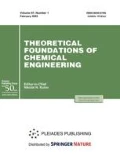Abstract
The potential to organize steady-state self-sustaining processes of the softening–desalination of brackish water was studied in a numerical experiment on the example of multicomponent model solutions containing sodium and calcium chlorides and sulfates. In the steady-state, self-sustaining processes of softening, water is subjected to desalination by means of a cation-exchange resin, and the formed brine is used to regenerate this cation-exchange resin in repeated sorption–desorption cycles without the addition of any surplus reagents. The interest in self-sustaining processes is associated with new technological opportunities in the creation of a new generation of water-treatment systems, e.g., mobile, stand-alone setups or systems with a high degree of freshwater recovery. The calculations of ion-exchange dynamics have been carried out for dozens of consecutive softening–desalination cycles via changes in the varied parameters, in particular, the ratio of components in the initial solution and the composition of desalted water. The conditions under which no steady-state regimes are formed or attained are shown. Based on the results of numerical experiments, a criterial relationship for the preliminary estimation of the feasibility of self-sustaining processes is proposed.









Similar content being viewed by others
REFERENCES
Klein, G. and Vermeulen, T., Cyclic performance of layered beds for binary ion exchange, AIChE Symp. Ser., 1975, vol. 71, no. 152, p. 69.
Barba, D., Brandani, V., and Foscolo, P.U., A method based on equilibrium theory for a current choice of cationic resin in sea water softening, Desalination, 1983, vol. 48, no. 2, p. 133.
Tokmachev, M.G., Tikhonov, N.A., and Khamizov, R.Kh., Investigation of cyclic self-sustaining ion exchange process for softening water solutions on the basis of mathematical modeling, React. Funct. Polym., 2008, vol. 68, p. 1245.
Khamizov, R.Kh., Komarova, I.V., Galkina, N.K., and Prudkovskii, A.G., Self-sustaining processes of water softening and desalination: Simple two-component systems, Theor. Found. Chem. Technol., 2020, vol. 54, no. 5, p. 919.
Khamizov, R.Kh., Tikhonov, N.A., and Morales, J.G., Clean (“green”) ion exchange technologies. IV: High-Ca-selectivity ion-exchange material for self-sustaining decalcification of mineralized waters process, Ind. Eng. Chem. Res., 2004, vol. 43, no. 8, p. 1868.
Boodo, F., US Patent US20110278225A1, Method for purifying water by cyclic ionic exchange, Published November 17, 2011.
Flodman, H.R. and Dvorak, B.I., Brine reuse in ion-exchange softening: Salt discharge, hardness leakage, and capacity tradeoffs, Water Environ. Res., 2012, vol. 84, no. 6, p. 535.
Khamizov, R.Kh. and Khamizov S.Kh., RF Patent 2686147, A method to process natural brackish waters on an ion-exchange resin to obtain solutions of complex mineral fertilizers and a plant for this process (variants), Byull. Izobret., 2019, no. 12. Published April 24, 2019.
Tang, S., Brinchak, L., Cohen, Y., and Lahav, O., Selective separation of divalent ions from seawater using an integrated ion-exchange/nanofiltration approach, Chem. Eng. Proc. Proc. Intensif., 2018, vol. 126, p. 8.
Brinchak, L., Keller, O., Tang, S., Fridman-Bishop, N., and Lahav, O., A membrane-based recycling process for minimizing environmental effects inflicted by ion-exchange softening applications, Sep. Purif. Technol., 2019, vol. 223, p. 23.
Safonyk, A., Prysiazhniuk, I., Prysiazhniuk, O., and Naumchuk, O., Mathematical modeling singularly perturbed processes of water softening on sodium-cationite filters, IAPGOS, 2019, no. 1, p. 37.
Komarova, I.V., Galkina, N.K., and Prudkovskii, A.G., Computational experiment as a method to estimate the efficiency of the operation of water treatment plants in co- and countercurrent regeneration of ion-exchange filters, Sorbtsionnye Khromatogr. Protsessy, 2018, vol. 18, no. 5, p. 776.
Lur’e, Yu.Yu., Handbook of Analytical Chemistry, Moscow: Khimiya, 1989.
Komarova, I.V., Galkina, N.K., Prudkovskii, A.G., and Khamizov, R.Kh., Mathematical modeling and calculation of the process of demineralization of water in an industrial filter: Communication 1. Hydrodynamics of regeneration and washing of an industrial filter, Sorbtsionnye Khromatogr. Protsessy, 2017, vol. 17, no. 1, p. 10.
Amir Abbas Izadpanah, Asghar Javidnia. The ability of a nanofiltration membrane to remove hardness and ions from diluted seawater, Water, 2012, vol. 4, p. 283.
Bargeman, G., Steensma, M., Kate, A., Westerink, J.B., Demmer, R.L.M., Bakkenes, H., and Manuhutu, C.F.H., Nanofiltration as energy-efficient solution for sulfate waste in vacuum salt production, Desalination, 2009, vol. 245, p. 460.
Author information
Authors and Affiliations
Corresponding author
Additional information
Translated by E. Glushachenkova
Rights and permissions
About this article
Cite this article
Khamizov, R.K., Komarova, I.V., Galkina, N.K. et al. Self-Sustaining Water Softening–Desalination Processes: Chloride–Sulfate Systems. Theor Found Chem Eng 56, 186–199 (2022). https://doi.org/10.1134/S0040579522020099
Received:
Revised:
Accepted:
Published:
Issue Date:
DOI: https://doi.org/10.1134/S0040579522020099




